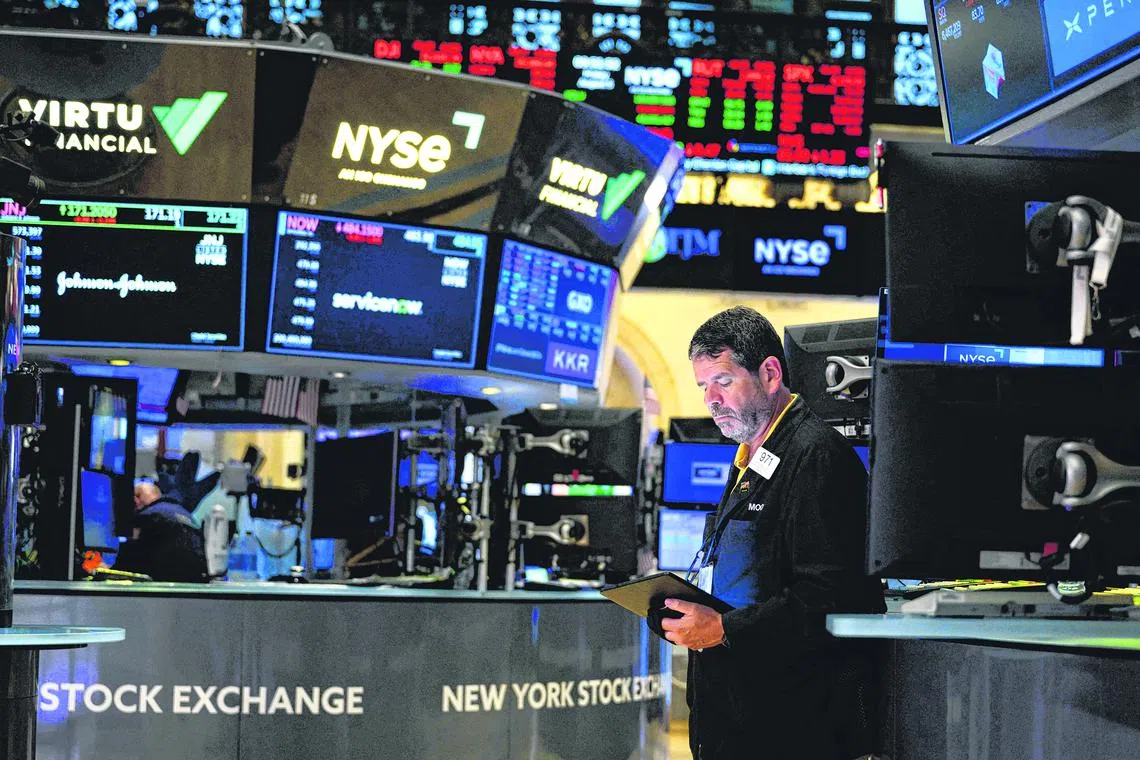Markets head northwards on hopes of falling inflation, Fed pivot
Sign up now: Get ST's newsletters delivered to your inbox

In the coming weeks, all eyes will be on the US second-quarter reporting season, which kicked off last Friday.
PHOTO: AFP
Follow topic:
SINGAPORE – Markets rallied last week amid signs that cooling inflation might help the United States economy avert a deep recession. There is also optimism – or hope – that the upcoming results season could surprise on the upside.
The Dow Jones put on its best weekly performance since March as it gained 2.3 per cent last week to 34,509.03, bringing its year-to-date gain to almost 4 per cent.
The broader S&P 500 closed 2.4 per cent higher at 4,505.42 points for the week, while the Nasdaq was up 3.3 per cent to 14,113.7 points.
Singapore’s Straits Times Index (STI) rallied 3.5 per cent last week to 3,248.63, more than recovering from the preceding week’s 2.1 per cent decline. As the recovery firmed, more traders participated, with Thursday seeing close to $1.5 billion worth of stocks changing hands.
The three local banks averaged a 2.8 per cent gain on the week, while Singtel rallied 4 per cent, which includes a 1.2 per cent gain on Friday following the release of Singapore’s advance gross domestic product estimates. Tech heavyweights Venture, AEM and UMS also averaged a 3.8 per cent gain on the week.
News of the Corrupt Practices Investigation Bureau’s investigation of tycoon Ong Beng Seng sent his Hotel Properties Limited shares tumbling some 4 per cent initially,
Seatrium was the STI’s flier for the week, gaining 16 per cent to 14.5 cents. On July 12, the company announced it had secured a green trade finance facility from OCBC Bank worth an estimated $1.04 billion.
Shares of Thomson Medical Group saw active trading on news that the Singapore-listed healthcare provider is buying into Vietnam’s largest private hospital group,
So what’s next for the market?
Although the S&P 500 index has rallied almost 15 per cent in 2023, most of the upside has been due to technology stocks. In fact, tech stocks within the broad-based index have rallied more than 36 per cent this year. The top five tech stocks by market capital – Apple, Microsoft, Alphabet, Amazon and Nvidia – are collectively up a whopping 70 per cent.
All eyes are now on the July 26 Federal Open Market Committee meeting, and the message that will come from it.
Although the United States consumer price index has fallen for the third consecutive month to hit 3 per cent for June – one-third the level of a year ago – some Fed governors are not convinced that it is time to pull back from the tight monetary stance.
Federal Reserve governor Christopher Waller last week insisted that the US central bank should go ahead with two more 25-basis-point rate hikes this year.
“I see two more 25-basis-point hikes in the target range over the four remaining meetings this year as necessary to keep inflation moving towards our target,” Mr Waller said in a speech to bond market experts at New York University.
If Mr Waller gets his way, the key Fed funds rate would hit the 5.5 per cent to 5.75 per cent range, its highest in four decades. However, Fed funds barometer CME FedWatch’s expectations for the rate ending the year above an upper band of 5.5 per cent has halved.
Meanwhile, the US dollar index declined significantly over the Asia week, forming its lowest levels for the year to date and returning to levels last seen in April 2022. The move in the US dollar coincided with two-year US Treasury yields declining from 4.93 per cent at the Friday close in New York to near 4.6 per cent at the Asia close.
Given the mixed messages, investors have been understandably cautious on the investment outlook. This is not necessarily a bad thing for markets because it represents a healthy level of scepticism and indicates a lot of dry powder on the sidelines. This can offer firepower to fuel more upside for markets going forward once bluer skies appear.
In the coming weeks, all eyes will be on the US second-quarter reporting season, which kicked off last Friday. If the results season surprises on the upside, markets could head higher. After all, as some market insiders like to point out, there is well over US$3 trillion of money market funds still not invested.
According to data compiled by FactSet on July 7, 113 of the S&P 500 companies have issued earnings guidance for the second quarter so far. Of these, 46 have issued positive guidance that is well above the numbers for the past few quarters. In fact, the second quarter has seen the highest number of S&P 500 companies issuing positive guidance for a quarter since the third quarter of 2021.
Another potential silver lining for the markets – especially in the Asia-Pacific – is the possibility of more stimulus from China following the Politburo meeting later in July, which traditionally sets the tone for economic policy for the second half of the year.
China’s economic recovery has been losing steam in recent months amid renewed weakness in the property market, the deep indebtedness of local governments, record high youth unemployment, sluggish household and business confidence, and fraught geopolitical tensions.
China will release a slew of economic data this week, including its second-quarter economic growth rate along with key data for June on retail sales, industrial production, fixed-asset investments and property investments. If the data comes in better than expected, it should be good news for undervalued Chinese equities and global markets.
A number of key US economic data reports are also scheduled for release. Positive numbers may inject optimism about the US economy and push back on recession fears.
US retail sales and industrial output figures, due on Tuesday, are expected to show improvements that augur well for the US economy. This could be supported by initial and subsequent US jobless claims figures that are also on tap this week. Consensus forecasts also expect the Philadelphia Fed index and the index of leading indicators for the US, due by Thursday, to show that the situation has become less negative in comparison to the preceding months.
“Overall, while there are reasons to be careful in the short term given continued headwinds, investors should not lose sight of the medium to longer term, which remains relatively sanguine,” said Mr Vasu Menon, managing director for investment strategy at OCBC. “Our fundamental views on wealth management remain unchanged. For prudence, investors should always have a balance of assets in their portfolios, including exposure to equities, bonds and even commodities.”
While another 25-basis-point rate hike appears a certainty this month, the Fed is approaching a pivot point.
Past interest rate cuts by the Fed have generally resulted in strong market rallies. If the US central bank pivots next year, and if there is no hard landing in the US and other major global economies, this could offer greater conviction for the sizeable amount of idle funds sitting on the sidelines to get back into markets.
So, stay invested.


